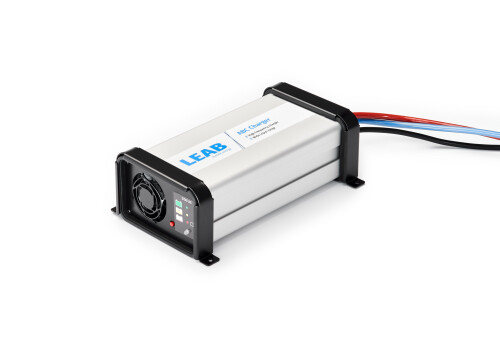
Our ABC series battery chargers can be adjusted precisely to the batteries needs.
Better take a closer look: When it comes to charging auxiliary batteries in vehicles, not all battery chargers are the same. If you want to charge your batteries gently and exactly according to the manufacturer's specifications, you have to adapt the charging programme individually to the battery. That is why LEAB battery chargers have IUoU charging curves. This means that they are not only suitable for all common types of batteries, but are also suitable for permanent trickle charging.
Mostly, an auxiliary battery is charged via an external 230-volt supply. This household voltage is fed into the battery charger, where it is converted into12-, 24- or 48-volt. Depending on the type of auxiliary battery (e. g. lead-acid or lithium-ion), different charging characteristics are necessary to charge the batteries as gently as possible.
A charging characteristic, or charging method, describes nothing more than the different ways of controlling current and voltage when charging a battery. The primary aim is always to fully charge the battery. In addition, the charging characteristic is a factor in the maintenance of the battery and the preservation of the state of charge. Depending on the battery type, different procedures are necessary.
The battery chargers of the ABC series from LEAB, for example, have 15 different charging characteristics, so the devices can be adjusted precisely to the different types of batteries and therefore be charged in terms of voltage, current and capacity. This enables the best possible charging and thus ensures maximum battery life.

Our ABC series battery chargers can be adjusted precisely to the batteries needs.
Unlike standard battery chargers, battery chargers with an IUoU characteristic are able to switch to trickle charge after the normal charging process. For this purpose, they initially function as usual: a phase with constant current is followed by a phase with constant voltage. The subsequent trickle charge ensures that the effect of self-discharge of the battery is counteracted. Thus, lead batteries, for example, can be charged permanently.
Definitely: The stated charging voltage of a battery always refers to charge at room temperature. At low temperatures, however, a higher charging voltage is needed to achieve the same effect and to fully charge the now weaker battery.
At high temperatures, e. g. in summer and/or in direct sunlight, the battery takes up less charge and begins to gas earlier. Therefore, the charging voltage needs reducing to ensure gentle charging and prevent unnecessary gassing.
The use of battery chargers with temperature sensors always makes sense when vehicles are to be charged outdoors or in non-air-conditioned halls. This is the only way to ensure a long battery life and the operational capability of the vehicle.
It is not always possible to assemble the battery charger close to the battery (you’ll find an explanation on how built-in battery chargers get around this problem further down in the article). Therefore, it is important to keep in mind that with increasing cable length, the voltage drop also increases and the battery may no longer be sufficiently charged. To prevent this, combined temperature and voltage sensors are the solution. In addition to the ambient temperature, they monitor the voltage directly at the battery terminals and raise the voltage accordingly if necessary. This compensates the loss and enables the best possible charge.
Different types of batteries have different charging requirements. If the charging voltage is too high for the battery, overcharging it the result. The battery begins to boil and gas out, leading to premature failure.
If the charging voltage is too low, the battery cannot be charged fully. This initially manifests itself in reduced capacity and thus shorter running time. In addition, the battery sulphates, lead sulphate crystals are deposited on the lead plates. This leads to poorer responsiveness and, over time, to a permanent loss of performance or even battery failure.
Therefore, when selecting a battery charger, it is important to make sure that the device is also suitable for the battery.
To charge your batteries optimally, the charging current should be between 10 % and 30 % of the capacity. For a battery with a capacity of 100 Ah, the following applies: 10 A to 30 A charging current. If additional consumers have to be supplied during the charging process, the demand increases accordingly. However, this is only a rough estimate. Whenever possible, seek advice from experts in order to obtain the optimal battery charger specifically and with a guarantee.
The permanent assembly of battery chargers in vehicles has several decisive advantages compared to a classic external assembly in the vehicle hall.
No voltage drop
Long cable runs, e.g. by positioning the battery charger under the ceiling of the hall and/or using a spiral cable, lead to high cable resistance and thus to a voltage drop between the battery charger and the battery. Poor charging, sulphating and ultimately premature battery failure are the result. Built-in battery chargers, on the other hand, can be installed close to the battery to prevent this problem.
Higher performance
DC supply systems are often only approved up to 16 amps. A 230 V feed can transmit almost 10 times the power at 16 amps in contrast to 24 volts, so that even powerful battery chargers in the vehicle can be supplied without any problems.
If you have any further questions or if we can consult you on suitable battery chargers, please do not hesitate to contact us. Our experts are happy to help and find the best setup for you and your batteries.